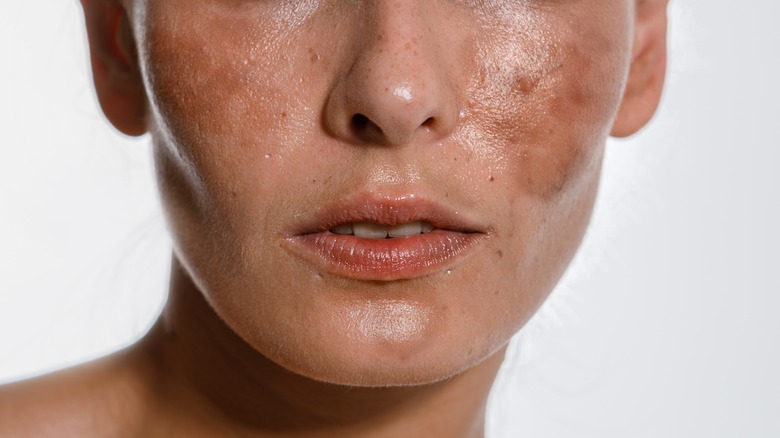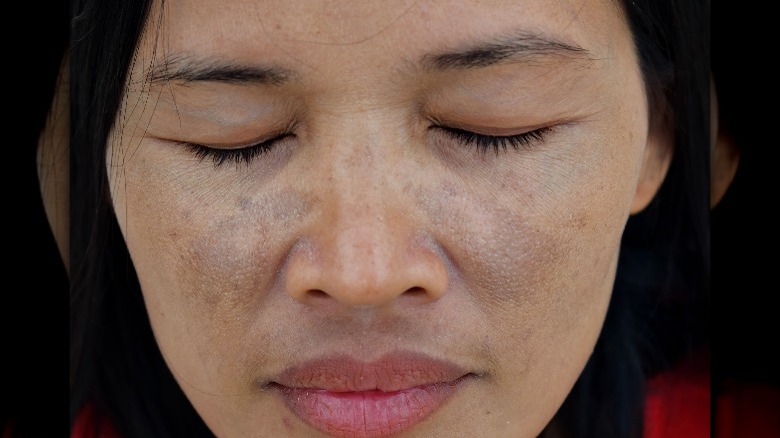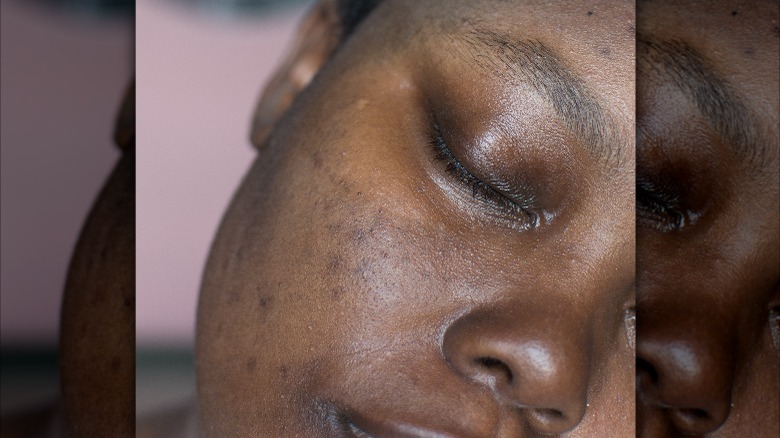Melasma 101: Why You Get It And How To Say Goodbye To It
If you're struggling with melasma, you're not alone. It's not unusual to notice an increase in patches and spots of darker brown or gray pigmentation as you age or as events in your life change. We're talking about hormone changes, typically, which is why melasma is more common in women than in men. Melasma tends to appear on the forehead, cheeks and cheekbones, nose, and in some cases, around the mouth. It can also appear on both sides of the face. It can appear on other parts of the upper body that typically see sun exposure, like the shoulders and upper back. The skin discoloration tends to affect people with darker skin tones, so if you tan well, you might be someone who has melasma or will be prone to it eventually.
The skin condition can be caused by several different factors and, in some cases, it's not always clear what causes melasma. On top of that, it can be tough to get rid of. In fact, in some cases you can't remove melasma entirely. However, the good news is that there are several options to lessen the severity of the skin condition and hopefully eradicate it entirely.
What causes melasma
There are several different factors that can contribute to melasma. Women can notice it when their hormone levels shift, specifically estrogen. For some, if they start taking hormonal birth control, they can notice an increase in the pigment disorder. Since hormone levels change during pregnancy, melasma is most common in pregnant women. In fact, its colloquial name is "the mask of pregnancy." But hormone shifts from menopause and even monthly menstrual cycles can trigger melasma. While hormone shifts seem to be the biggest factor, it takes more than just hormone changes to create melasma. Dermatologist Dr. Corey Hartman told Byrdie what this trifecta is: "It exists at the intersection of ultraviolet light exposure, heat exposure, and hormone changes."
Ultraviolet light from the sun is especially bad for exacerbating melasma, as are tanning beds due to their UV lights. In some cases, thyroid diseases can also exacerbate melasma. In addition, genetics can play a factor in your likelihood to have melasma. According to the Cleveland Clinic, between 33 percent to 50 percent of people with melasma indicated that they had relatives who also had it.
How melasma affects your skin
Melasma is not a form of skin cancer. Melasma isn't painful or itchy either and the pigmentation has no different texture from the rest of your skin. While melasma presents no health risks, the issues are more emotional. For many who develop melasma, new patches of discoloration can be distressing.
Melasma can cause the same frustrations as any other visible skin condition. Thankfully, since it's not textured, concealers and products can work well to cover it. Makeup artist Tara Dowburd told Ipsy, "Before applying foundation, I recommend using a color correcting, full-coverage concealer on the specific areas you want to neutralize." She added, "if you have a medium-to-dark skin tone, you want to use a deep orange or red tone color correcting concealer and if you have light-to-medium skin tone, you want to use a pinky peach tone." Follow with a full-coverage foundation. Even though melasma is harmless, when in doubt about new appearances on skin, it's always a good idea to consult your doctor.
How to treat melasma
The first step in taking care of melasma is to meet with a dermatologist and establish that the dark patches are indeed melasma. This is helpful not only in establishing a care plan but also to eradicate, as much as possible, the problems that are causing melasma. Since sun exposure exacerbates melasma, it's essential that you wear sunscreen and keep skin covered.
The best topical treatment tends to be Tretinoin or another retinol-based product. "The classic treatment for melasma is a prescription topical cream composed of retinoic acid, hydroquinone, and a corticosteroid," dermatologist Heidi Waldorf told The Cut. Consult your doctor if you're pregnant, as some of these ingredients may not be acceptable. There are also ingredients that you can use at home to help with melasma. Kojic acid is an excellent option.
"It works by blocking tyrosine from forming, which then prevents melanin production," dermatologist Dr. Hadley King told Byrdie. Niacinamide also works well, as does licorice extract. "Therapies include topical lightening agents like hydroquinone, cysteamine, tranexamic acid, and azelaic acid," Hartman told Byrdie. If you need more intense treatment, there are several options that you can discuss with your dermatologist. "Lasers like Picosure and Fraxel, chemical peels, and microneedling are also potential treatment options," Hartman added.



